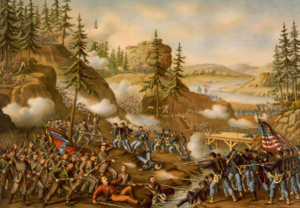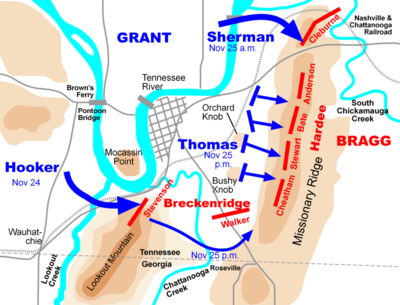Difference between revisions of "Battle of Chattanooga" - New World Encyclopedia
Laura Brooks (talk | contribs) (→Notes) |
Laura Brooks (talk | contribs) |
||
| Line 78: | Line 78: | ||
| − | + | ||
| − | |||
| − | |||
Revision as of 19:09, 22 February 2007
| First Battle of Chattanooga | |||||||
|---|---|---|---|---|---|---|---|
| Part of American Civil War | |||||||
| |||||||
| Combatants | |||||||
| United States of America | Confederate States of America | ||||||
| Commanders | |||||||
| James S. Negley | E. Kirby Smith | ||||||
| Strength | |||||||
| One division of the Dept of the Ohio | Army of Kentucky | ||||||
| Casualties | |||||||
| 23 | 65 | ||||||
The first part of the Battle of Chattanooga was a minor battle occurring from June 7 to June 8, 1862. The larger and more famous battle was the third part in November, 1863.
In late spring 1862, the Confederacy split its forces in Tennessee into several small commands in an attempt to complicate Federal operations. The Union army had to redistribute its forces to counter the Confederate command structure changes. Major General Ormsby M. Mitchel received orders to take his division to Huntsville, Alabama, to repair railroads in the area. Soon, he occupied more than one hundred miles along the Nashville & Chattanooga and Memphis and Charleston railroads. In May, Mitchel and his men fought with Major General Edmund Kirby Smith’s men.
After Mitchel received command of all Federal troops between Nashville and Huntsville, on May 29, he ordered Brig. Gen. James Negley with a small division to lead an expedition to capture Chattanooga. This force arrived before Chattanooga on June 7. Negley ordered the 79th Pennsylvania Volunteers out to reconnoiter. It found the Confederates entrenched on the opposite side of the river along the banks and atop Cameron Hill. Negley brought up two artillery batteries to open fire on the Rebel troops and the town and sent infantry to the river bank to act as sharpshooters. The Union bombardment of Chattanooga continued throughout the 7th and until noon on the 8th. The Confederates replied, but it was uncoordinated since the undisciplined gunners were allowed to do as they wished. On June 10, Smith, who had arrived on the 8th, reported that Negley had withdrawn and the Confederate loss was minor. This attack on Chattanooga was a warning that Union troops could mount assaults when they wanted.
The second part of the Battle of Chattanooga was a battle ,beginning on August 21, 1863, as the opening battle in the Chickamauga Campaign. On August 16, 1863, Major General William S. Rosecrans, commander of the Army of the Cumberland, launched a campaign to take Chattanooga. Colonel John T. Wilder’s brigade of the Union 4th Division, XIV Army Corps, marched to a location northeast of Chattanooga where the Confederates could see them, reinforcing General Braxton Bragg’s expectations of a Union attack on the town from that direction. On August 21, Wilder reached the Tennessee River opposite Chattanooga and ordered the 18th Indiana Light Artillery to begin shelling the town. The shells caught many soldiers and civilians in town in church observing a day of prayer and fasting. The bombardment sank two steamers docked at the landing and created a great deal of consternation amongst the Confederates. Continued periodically over the next two weeks, the shelling helped keep Bragg's attention to the northeast while the bulk of Rosecrans' army crossed the Tennessee River well west and south of Chattanooga. When Bragg learned on September 8 that the Union army was in force southwest of the city, he abandoned Chattanooga.
| Battle of Chattanooga | |||||||
|---|---|---|---|---|---|---|---|
 | |||||||
| |||||||
The third part of the Battle of Chattanooga (popularly known as The Battle of Chattanooga) was fought from November 23 to November 25, 1863, in the American Civil War. By defeating the Confederate forces of General Braxton Bragg, Union Army Major General Ulysses S. Grant eliminated the last Confederate control of Tennessee and opened the door to an invasion of the deep South that would lead to the Atlanta Campaign of 1864.
Prelude to battle
After their disastrous defeat at the Battle of Chickamauga, the 40,000 men of the Union Army of the Cumberland under Major General William Rosecrans retreated to Chattanooga, Tennessee. Confederate General Braxton Bragg's Army of Tennessee besieged the city, threatening to starve the Union forces into surrender. His pursuit to the city outskirts had been leisurely, giving the Union soldiers time to prepare defenses. Bragg's troops established themselves on Missionary Ridge and Lookout Mountain, both of which had excellent views of the city, the river, and the Union's supply lines. Confederate troops launched raids on all supply wagons heading toward Chattanooga, which made it necessary for the Union to find another way to feed their men.
The Union government, alarmed by the potential for defeat, sent reinforcements. On October 17, Maj. Gen. Ulysses S. Grant received command of the Western armies, designated the Military Division of the Mississippi; he moved to reinforce Chattanooga and replaced Rosecrans with Maj. Gen. George H. Thomas. Devising a plan known as the "Cracker Line", Grant's chief engineer, William F. "Baldy" Smith, launched a surprise amphibious landing at Brown's Ferry that opened the Tennessee River by linking up Thomas's Army of the Cumberland with a relief column of 20,000 troops led by Maj. Gen. Joseph Hooker, thus allowing supplies and reinforcements to flow into Chattanooga, greatly increasing the chances for Grant's forces. In response, Bragg ordered Confederate Lieutenant General James Longstreet to force the Federals out of Lookout Valley. The ensuing Battle of Wauhatchie (October 28 to October 29, 1863]]) was one of the war's few battles fought exclusively at night. The Confederates were repulsed and the Cracker Line was secured.
Bragg weakened his forces by sending Longstreet's corps moving against Maj. Gen. Ambrose Burnside near Knoxville. When Maj. Gen. William T. Sherman arrived with his four divisions (20,000 men) in mid-November, Grant began offensive operations.
November 23: Initial movements
On November 23, Union forces under Thomas struck out and advanced east to capture a line from Orchard Knob to Bushy Knob, placing them halfway to the summit of Missionary Ridge. The advance was made in broad daylight and met little Confederate resistance. Bragg moved Walker's division (under Brig. Gen. States Rights Gist) from Lookout Mountain to strengthen his right flank.
November 24: Battle of Lookout Mountain
The plan for November 24 was a two-pronged attack—Hooker against the Confederate left, Sherman the right. Hooker's three divisions struck at dawn at Lookout Mountain and found that the defile between the mountain and the river had not been secured. They barreled right through this opening; the assault ended around 3:00 p.m. when ammunition ran low and fog had enveloped the mountain. This action has been called the "Battle Above the Clouds" due to that fog. Bragg withdrew his forces from the southern end of the mountain to a line behind Chattanooga Creek, burning the bridges behind him.
Sherman crossed the Tennessee River successfully, but his assault was then delayed and the division of Patrick Cleburne was rushed in to reinforce the Confederate right flank. No attack would occur on this flank on the 24th.
November 25: Battle of Missionary Ridge
On November 25, Grant changed his plan and called for a double envelopment by Sherman and Hooker. Thomas was to advance after Sherman reached Missionary Ridge from the north. The Ridge was a formidable defensive position, manned in depth, and Grant knew that a frontal assault against it would be suicidal, unless it could be arranged in support of the flanking attacks by Sherman and Hooker. As the morning progressed, Sherman was unable to break Cleburne's line and Hooker's advance was slowed by the burned bridges on the creek. At 3:30 p.m., Grant was concerned that Bragg was reinforcing his right flank at Sherman's expense. Hence, he ordered Thomas to move forward and try to seize the first of three lines of Confederate entrenchments to his front. The Union soldiers moved forward and captured the first line, but were subjected there to punishing fire from the two remaining Confederate lines up the ridge. Most of these units had been at the disastrous loss at Chickamauga and had suffered the taunts by Sherman's and Burnside's newly arrived forces. Now they were under fire from above with no apparent plan to advance or move back. Without orders, the Union soldiers continued the attack against the remaining lines. They advanced doggedly up the steep slope, shouting "Chickamauga, Chickamauga!" until they finally overwhelmed and captured the remaining Confederate lines. Bragg had misplaced his artillery on the crest of the ridge, rather than the military crest, and it was unable to provide effective fire. Nonetheless, the Army of the Cumberland's ascent of Missionary Ridge was one of the war's most dramatic events. A Union officer recalled that "little regard to formation was observed. Each battalion assumed a triangular shape, the colors at the apex. ... [a] color-bearer dashes ahead of the line and falls. A comrade grasps the flag. ... He, too, falls. Then another picks it up ... waves it defiantly, and as if bearing a charmed life, he advances steadily towards the top ..."[1]
Grant was initially furious that his orders had not been followed exactly. Thomas was taken by surprise as well, knowing that his head would be on the chopping block if the assault failed. But it succeeded. By 4:30 p.m., the center of Bragg's line broke and fled in panic requiring the abandonment of Missionary Ridge and a headlong retreat into Georgia.
Aftermath
During the night, Bragg ordered his army to withdraw toward Dalton; Grant was unable to organize an effective pursuit. Casualties for the Union Army amounted to 5,824 (753 killed, 4,722 wounded, and 349 missing) of about 56,000 engaged; Confederate casualties were 6,667 (361 killed, 2,160 wounded, and 4,146 missing, mostly prisoners) of 46,000. When a chaplain asked General Thomas whether the dead should be sorted and buried by state, Thomas replied "Mix 'em up. I'm tired of States' rights."[2]
One of the Confederacy's two major armies was routed. The Union held Chattanooga, the "Gateway to the Lower South." It became the supply and logistics base for Sherman's 1864 Atlanta Campaign, and Grant had won his final battle in the west prior to receiving command of all Union armies in March 1864.
ReferencesISBN links support NWE through referral fees
- Catton, Bruce. The American Heritage Picture History of the Civil War. New York Bonanza Books, 1982, 1960 ISBN 0517385562
- Eicher, David J. The Longest Night: A Military History of the Civil War. New York Simon & Schuster, 2001 ISBN 0684849445
- McDonough, James Lee. Chattanooga: A Death Grip on the Confederacy. Knoxville, Tennessee The University of Tennessee Press, 1984 ISBN 0870494252
Credits
New World Encyclopedia writers and editors rewrote and completed the Wikipedia article in accordance with New World Encyclopedia standards. This article abides by terms of the Creative Commons CC-by-sa 3.0 License (CC-by-sa), which may be used and disseminated with proper attribution. Credit is due under the terms of this license that can reference both the New World Encyclopedia contributors and the selfless volunteer contributors of the Wikimedia Foundation. To cite this article click here for a list of acceptable citing formats.The history of earlier contributions by wikipedians is accessible to researchers here:
The history of this article since it was imported to New World Encyclopedia:
Note: Some restrictions may apply to use of individual images which are separately licensed.
